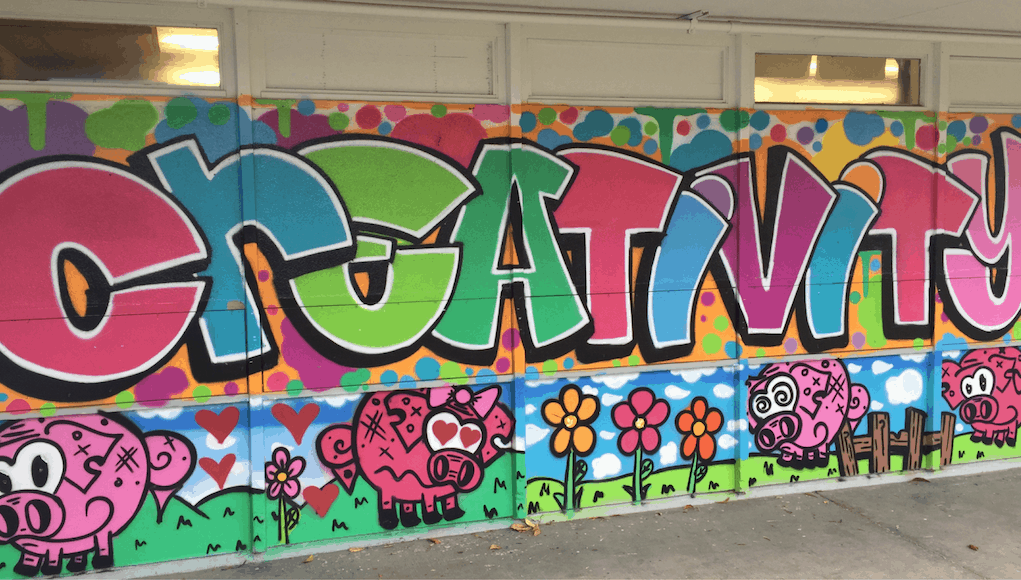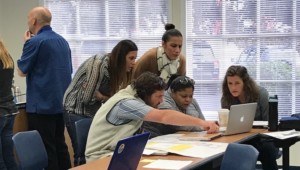A Year in Review: High-Quality Project Based Learning

Projects are an easy way to engage students in authentic challenges but delivering all of possible benefits requires well constructed, sustained and supported experiences. Earlier this year, a new Framework for High Quality Project Based Learning (HQPBL) was developed to help teachers better prepare young people for contribution in the innovation economy.
As we look back, it is evident that project-based learning not only increases student engagement, it helps students develop academic and social and emotional skills for life and careers.
Over the year, we visited 8 schools where students are having HQPBL experiences, here is what we discovered:
Case Studies

HQPBL Case Study: Katherine Smith School. Over seven years ago, Aaron Brengard came to serve as principal of Katherine Smith Elementary, a 55-year-old Title I school within San Jose’s Evergreen School District. Despite its location in Silicon Valley, the school seemed a world apart from the region recognized globally for entrepreneurship and innovation.
From the very beginning of his tenure, Brengard championed a school redesign that would better prepare students for the real world. The lessons learned from this journey toward High Quality Project Based Learning (HQPBL) remain relevant, as they could potentially be applied to public schools across America (Read Case Study).
HQPBL Case Study: Energy Institute High School. In east downtown Houston, you’ll find the nation’s first high school devoted to preparing students to enter careers in the energy field. Energy Institute High School is a STEM-focused magnet program with project-based learning at its core. The school began with an acknowledgment of local businesses and the demand for students to enter the ever-growing energy industry in the Houston area. It has since become a place of learning where “students are exposed to engineering and technology typically reserved for college-level courses, and they also receive instruction from teachers as well as industry professionals.” Daily students are having HQPBL experiences and growing their real-world industry savvy (Read Case Study).
HQPBL Case Study: ACE Leadership High School. Northwest of downtown Albuquerque, there is a high school of about 400 students, ranging in ages from 14-20, that is proving Project Based Learning really is for all students. ACE Leadership High School primarily serves students who have already, or seemingly were on their way to, dropping out of high school. On average, students at ACE have been enrolled in three or more high schools and many claim that school wasn’t working for them. Many hold jobs, sometimes even two, and typically come from low socioeconomic backgrounds.
The founders of ACE knew that high quality Project Based Learning (HQPBL) was an antithesis to the type of learning experiences these students were used to receiving; instead of trying the same methods with already disengaged and frustrated youth, HQPBL experiences would provide them with intellectual challenge, collaboration, management skills, public presentation skills, tactile feedback and reflection. Perhaps most important to founders of ACE, the approach would provide authentic and meaningful learning experiences (Read Case Study).
HQPBL Case Study: Liceo Pablo Neruda. When asked where the most advanced approaches to K-12 instruction are taking place, educational experts often point north toward Scandinavia. Yet one of South America’s coastal countries is showing a forward-thinking stance that would rival the world’s leading educational systems. In a variety of school networks across Chile, facilitating high quality project based learning student experiences has gained momentum toward becoming a national movement.
With a population of nearly 18 million and per capita income hovering around $15,000, the country faces plenty of challenges in terms of providing services to its citizens—education included. As K-12 education is compulsory, the majority of current students are children of parents who have completed high school. However, fewer than 10% have gone on to attain a college degree.
Project Based Learning is connecting communities, foundations and corporations; students, parents, and educators at the K-12 and postsecondary levels are engaging in projects and training that will impact this generation and those to follow. The assignments are authentic in that they enable students to engage with and address relevant local issues that matter to them, culminating in a public presentation and reflection period in which lessons learned are articulated and discussed. These highly collaborative, well-managed projects exemplify HQPBL student experiences and demonstrate the country’s progressive stance on education (Read Case Study).
HQPBL Case Study: Albemarle County Public Schools. Without a doubt, Project Based Learning in Albemarle County Public Schools is there to stay. From impressive outcomes, both in project products and on state assessment measures, teachers, students and families are seeing the results of high quality PBL (HQPBL) student experiences. Most projects in ACPS are tied to the local area, a region of the country rich with history and culture, and invite students to explore their own community.
From Elementary students at the local schools investigating attractions and writing to the Mayor — all the way up through high school where students are considering what makes memorials important to society — there is no lack of authenticity and collaboration. Students not only work on projects tied to a real cause or community issue, but they also engage with the community and solicit feedback, advice and expertise to improve their public products (Read Case Study).
HQPBL Case Study: The MET School. “Working on high quality projects is at the core of the The Met… actually I’d like to rephrase that and say doing real-world, meaningful work is at the core. Projects are the vehicle for how students at Met get that done,” shared The Met Co-Founder Dennis Littky. Located in the heart of Providence, Rhode Island, the The Met is part of the Big Picture Learning network and was designed based on the idea that students thrive when they are engaged in real-world work and are able to integrate internships tied to their passions into in-depth, integrated high quality Project Based Learning (HQPBL) experiences.
Projects at The Met are connected to individual student goals, and each project includes specific skills students need to address. How does it work, exactly? Students are grouped in small cohorts (or essentially small communities), each with a bonding name like Unity or Liberty. Cohorts collaborate to tackle problems, support each other, and collaborate on projects (Read Case Study).
HQPBL Case Study: School21. If you walk the halls of the lively School21 in London’s Stratford neighborhood, you easily might hear dozens of languages being spoken. Many of the school’s more than 1000 students have immigrated from other parts of the world, and as such, enter their grade levels with varying degrees of experience with English.
In this intensely diverse environment, it might be challenging to meet every student’s academic needs; thankfully, the students share a common lexicon when it comes to Project Based Learning, and new arrivals are quickly brought into the fold by their peers and teachers (Read Case Study).
HQPBL Case Study: Thrive Public Schools. At Thrive Public Schools in San Diego, California—a school network with a strong focus on high quality Project Based Learning (HQPBL)—projects are a necessary part of reaching the diverse population served by the school. About half of Thrive students are eligible for free or reduced lunch; as many as one in four are identified as ‘exceptional learners’, and nearly 30% of students speak a language other than English at home.
With students coming from 45 different zip codes—including families of Somali refugees as well as San Diego’s most affluent families—there are some who travel over an hour each way in order to study at Thrive. They make up a religiously, ethnically and neurologically diverse cohort. The Thrive community views this diversity as one of their greatest strengths (Read Case Study).
Do you have good examples of HQPBL in your school? Share them below in the comment!
For more, see:
- What 100 School Visits Taught Us This Year
- Project-Based Schools Close Silicon Valley Gaps
- Students Learn Project Management From HQPBL Experiences
- What Does HQPBL Look, Sound, and Feel Like in a General Education Classroom?
This blog is a part of the HQPBL Campaign supported by the Buck Institute for Education and sponsored by the Project Management Institute Educational Foundation and the Hewlett Foundation. For more, visit hqpbl.org and follow @hqpbl and #hqpbl on Twitter and Instagram.
Stay in-the-know with innovations in learning by signing up for the weekly Smart Update. This post includes mentions of a Getting Smart partner. For a full list of partners, affiliate organizations and all other disclosures, please see our Partner page.




0 Comments
Leave a Comment
Your email address will not be published. All fields are required.